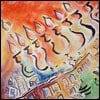On June 30, 1944, all of the remaining Jews in a small town north of Budapest called Szentendre were rounded up and shipped to their deaths in Auschwitz. Once part of a thriving Jewish community, these residents were but a small portion of the estimated 568,000 Hungarian Jews murdered by the Nazis in the last 14 months of World War II.
A paltry 40 Jews who survived the camps moved to the town after the war, free of the Nazi regime but soon to be subjected to Communist rule. By 1949, the returnees had managed to renovate a school building and set up a small place to pray inside, and erect a memorial to those who perished in the war.
Some 70 years later, with evidence of the external oppressors behind them—aside from the resurgent anti-Semitism in the world at large—a hearty crowd from the town’s estimated 120 Jewish households shed any reticence they might once have had to attend an outdoor Jewish celebration and stood alongside their new permanent Chabad-Lubavitch representative, Rabbi Menachem Mendel Myers, to witness the public lighting of a menorah Sunday on the first night of Chanukah. His wife and co-director, Tzivia, gave birth to the couple’s first child the week before and was unable to attend.
“This was a wonderful event, and it is really special that we have a new rabbi, and that we were able to celebrate this together on a rainy evening,” a Szentendre woman named Julia, who attended the event with her family, told Chabad.org. “It warms our hearts and the lights will follow us during the following year.”
The crowd stayed after the lighting to enjoy music and a children’s program, replete with all of the standard public Chanukah-lighting fare: latkes, doughnuts, hot winter beverages and hobnobbing with Szentendre Mayor Fulop Zsolt, who addressed the crowd.
Still abuzz from the inauguration of a new Chabad complex and Torah scroll in September, on the same day another new Budapest area Chabad synagogue and Torah scroll were dedicated, Myers, even with the inclement weather keeping some at home, was happy with the turnout.
“The rain didn’t help, but there were about 60 to 65 people who came to the event, more than I could have hoped for in this weather,” he said. “It was very nice.”

Judaism in an Artsy Suburb
The Chanukah program that took place under a steady rain was held in a square of the artsy and upscale Budapest suburb, with a population of about 25,000 people, that the couple inhabited as new Chabad-Lubavitch emissaries on Sept. 22, the same day as the Torah and Chabad center receptions. It paled in comparison in terms of numbers to the collosal annual “Chanukah on Ice” event produced by fellow emissaries the same night on a massive ice rink in Budapest’s Heroes’ Square.
Still, the Szentendre gathering represented the permanent renewal of activity on turf that has seen only the most cursory of Jewish life since before the Holocaust.
Present at the event was a 94-year-old man with memories of long-past attendance at a cheder (elementary Chassidic Jewish day school), who happened into the young couple’s sukkah on the holiday of Sukkot shortly after their arrival and now has somewhere to go for Shabbat.
“While not affiliated with organized Judaism for years, he was extremely excited to see us there,” Myers said about their Sukkot visitor. “Last week, we invited him for Shabbat services. While a bit lost in the beginning, his eyes lit up when I began singing ‘Lecha Dodi’ [the melodious prayer that opens the Friday-night Shabbat service].He exclaimed loudly, ‘This, I remember!’ ”
At the event was also a young boy who had been escorted by his mother to meet the couple last year on one of their preparatory trips. In November, under the rabbi’s tutelage, he became the first to celebrate a bar mitzvah in Szentendre since before the Holocaust.

Myers expressed particular joy in relating the story:
“She approached us on the street holding her son’s hand last Chanukah when we came on a pilot trip to distribute menorahs,” Myers related. She said: “I am Jewish. David here will be celebrating his bar mitzvah next November and I would like you to teach him. So it was written; so it was done. On parshat [the weekly Torah portion] Chayei Sarah, just the other week, we celebrated the first bar mitzvah in Szentendre since the Holocaust.”
He said 40 people gathered in the new community synagogue that the couple run “to celebrate with David on this significant day, significant not only for David, but for all those present who suffered and persevered through decades of persecution, all the while retaining their Jewish identity and pride, and, moreover, successfully conveying it to their children.”
In addition to the highly styled synagogue that was already operational for the High Holidays, Sukkot and Simchat Torah, an adjoining art gallery and kosher restaurant, all under the name the Chai Gallery, so titled to fit into the trendy town known as a haven for artists, is planned for completion in the spring.
The couple’s moment in the limelight is a repeat of some nine similar milestones for Jewish advancement in the Central European nation under the leadership of Chabad-Lubavitch emissaries, Rabbi Baruch and Batsheva Oberlander. In affiliation with EMIH (Unified Hungarian Jewish Congregation), an alliance-building umbrella organization formed in 2004 to help bring as many unaffiliated Jews as possible back to learning and practice, the Oberlanders since their arrival in 1989 have seen the establishment of 10 Chabad centers, an elementary school, a Jewish high school, 17 emissary couples and the erection or revival of several synagogues.

A Rich Jewish History
Like the newest emissary’s initial experiences, the narratives of Hungary’s entire Chabad team abound with poignancy in a country that for at least 100 years before the Holocaust was the scene of vibrant and bustling Jewish life and practice, with more than 70 yeshivahs, and ornate and majestic synagogues in abundance.
Rabbi Shlomo Koves, the first Hungarian-born rabbi to be ordained in the country after the Holocaust, was installed in a moving ceremony in 2003. Koves, who attended Sunday’s event, is the executive rabbi of the umbrella organization EMIH and a Chabad emissary with his own Budapest synagogue, along with his wife, Dvorah Leah, who directs a Sunday school.
Along with Hungary’s Deputy Prime Minister, Semjen Zsolt, Koves was one of the main speakers at the dedication ceremony of the two new Torahs and synagogues, which took place on the banks of the blood-soaked Danube River back in September.
“When my grandmother and I would pass by the river, she would say, ‘For me, the Danube isn’t blue; it’s red,’ ” he told the rapt audience. “And here we are, at the shore of the Danube at the same place where the Jews were shot into the river, and we commemorate the completion of two Torah scrolls, which represent the eternity of Jewish life.”
He was referring to a particularly horrifying atrocity that occurred in the final months of Hungary’s Holocaust nightmare, December 1944 through January 1945, when thousands of Jews were murdered en masse at the river’s edge after being ordered to remove their shoes. A permanent exhibit called: “Shoes on the Danube Bank,” an assembly of 1940s-era iron-sculpted shoes affixed to the ground, is a forever commemoration.

Oberlander, the son of Hungarian Holocaust survivors, also spoke, recalling how his father described the murder scene. Unable to hold back tears, he shared: “I thank the Almighty that I can be here, and dedicate two Torahs and pass on the teaching that was on their last breath.”
One of the Torahs will be housed in a new 27,000-square-foot Chabad center near the Shoes on the Danube memorial, co-directed by veteran Budapest emissary couple, Rabbi Shmuel and Shoshi Glitzenstein. The facility, currently being completed, will incorporate a synagogue, study hall, large playground and two kosher restaurants.
The other Torah’s home is Szentendre in the new synagogue directed by the couple, the scene of a joyful reception after a procession with the Torah through Szentendre’s narrow cobblestone streets in September. Among the attendees at the event were the rabbi’s parents, Rabbi Baruch and Chanie Myers, who have served as Chabad-Lubavitch emissaries in neighboring Slovakia since 1993.
Of the work the couple has cut out for themselves, Myers said: “Our Chabad House, Chai Gallery by name, is and will be an encompassing center of Jewish life. In it, we aim to harmonize all of the various aspects of Jewish life—from the religious to the cultural to the social elements.”
Of the response from the community so far, he shared: “We have had much positive feedback. The locals have been extremely welcoming. They have opened their hearts to us and have a strong desire to strengthen Jewish life here.”
Waxing more philosophical, he added: “I have learned that every individual who walks through our door has a sea of experiences and stories that brought him or her to the place he or she is at, and, when encouraged, their dams break, and we begin to fathom the truth of our sages comparison of a single life to an entire universe.”








Join the Discussion